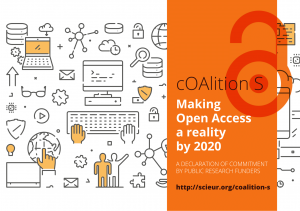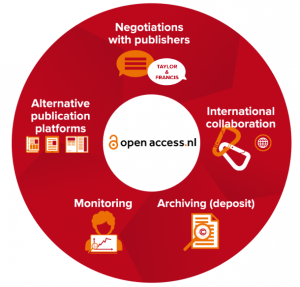These past few weeks I have experienced the difficulty of having different hats. As program manager open access at the VSNU and involved in the negotiations with the (bigger) publishers, I am positive about the recently announced plan of “cOAlition S”. It is helping us in our ambition that publicly-funded scientific publications must be accessible to all by 2020.
However there are a few points to make. First as Library Director and Chair of the UKB I very well understand that there are currently more questions than answers, and that a lot of these questions will be put at the libraries’ desks. LIBER, the Association of European Research Libraries supports the plan, because it “adds extra impetus to the need for libraries to fully back Open Access and Open Science”. Libraries have indeed been advocates for both open access and open science. Research libraries are supporting the primary processes of the university, and the research support they deliver relates to “setting up research”, “investigating & experimenting, and “publishing & outreach”, is covering a lot of elements in the research cycle. We also realize that for “setting up research” our researchers need access, also access to resources that are not yet available in open access. That can give some tension, because we value all our researchers, and want to give the best support possible. And it is good that we continue to bring the voice of the researchers when measures such as these are being constructed or implemented.
Fortunately we notice that access is becoming a commodity, and that our services need revision and rethinking. In the past we have added online (and preferably open) access to our physical collections, or replaced/canceled the physical collections if not unique or university specific. In future we need to bring this a step further, taking full use of the possibilities technology brings. The best access to relevant knowledge might not be brought to the researchers by or via us, but via disciplinary hubs. Will this perhaps connect us to the idea of federated infrastructures, now mainly referred to when talking about research data? Interesting and ongoing discussions for librarians, and something that we are heavily involved in.
And the second point I want to make is that there is a world between great and grand plans and the reality of today. One thing I can, as program manager open access at the VSNU, and will, do is to help finding some answers in the coming period. What is evident is that universities in the Netherlands argue that scientific knowledge is not a luxury item, and should be freely available (through open access) to everyone. Most research is, after all, publicly funded. Let me give it a start with my perspective (a lot has already been said in several commentary blogs, such as Peter Suber’s, or explanatory notes, such as in the preamble of Marc Schiltz, President of Science Europe).
Why does the plan of “cOAlition S” help us in our ambitions?
- The VSNU always prioritized the gold road as the most optimal way to reach immediate open access. In an article (preprint available, unfortunately no full and immediate open access yet!) I wrote with my colleague from the Library of the University of Amsterdam (Maria Heijne), we explain the advantage to try to reach open access via the current “license” contracts: “This approach will also avoid the creation of any unnecessary additional infrastructure and will not add to the further increase in the number of scientific journals”. The current offsetting deals the VSNU, in cooperation with UKB and Surfmarket, has reached are steps in the transition to full open access. As stated in the VSNU roadmap we cannot do this on our own; we need others to reach the same deals and convey the same message. By doing that the “hybrid” journals will reach a threshold and “flip” from mainly a toll-access journal, with a few open access articles, to a full open access journal. We have seen our offsetting deals as transitions to full open access, but also notice that these transitions are not really taking place (see also recent blogs in The Scholarly Kitchen, or OpenAIRE about this). This plan puts more pressure on the publishers to turn to full open access. Or as Marc Schiltz puts it: “We therefore invite publishers to switch to publication models that comply with these principles”.
- It is also important to note that the current deals are indeed seen, by the partners of “cOAlition S”, as stepping stones. Again from the preamble “We acknowledge that ‘transformative’ type of agreements, where subscription fees are offset against publication fees, may contribute to accelerate the transition to full Open Access. Therefore, it is acceptable that, during a transition period that should be as short as possible, individual funders may continue to tolerate publications in ‘hybrid’ journals that are covered by such a ‘transformative’ type of agreement. There should be complete transparency in such agreements and their terms and conditions should be fully and publicly disclosed.” NWO has incorporated this transition period in their press release (it ends at the end of 2021).
What does it mean for our authors?
- In principle we already ask our authors to opt for open access publications “as the default”, if possible. And the options to find these are increasingly available. In the journal browser UKB launched authors can check what the open access options are. Notably the journals in this browser all are quality peer-reviewed journals.
- Articles underway or to be accepted in the coming period, falling under our current VSNU contracts, and published open access, are compliant with NWO’s current and future guidelines (up to end 2021).
As said, the main question will be how the bigger publishers respond to this call of the funders. The key message, to have publicly funded scientific publications available open access for everybody, has not changed. The pace in which and the way how we are able to reach this should. I hope that all researchers and all supporting staff will feel motivated by this move. And I invite our Dutch (library-hat speaking) colleagues to join me in our discussions of the implications. We need to be creative, flexible and constructive again!


1 comment on "Too many hats?"